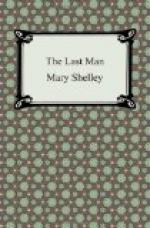Among other works of art in which he was engaged, he had projected the erection of a national gallery for statues and pictures. He possessed many himself, which he designed to present to the Republic; and, as the edifice was to be the great ornament of his Protectorship, he was very fastidious in his choice of the plan on which it would be built. Hundreds were brought to him and rejected. He sent even to Italy and Greece for drawings; but, as the design was to be characterized by originality as well as by perfect beauty, his endeavours were for a time without avail. At length a drawing came, with an address where communications might be sent, and no artist’s name affixed. The design was new and elegant, but faulty; so faulty, that although drawn with the hand and eye of taste, it was evidently the work of one who was not an architect. Raymond contemplated it with delight; the more he gazed, the more pleased he was; and yet the errors multiplied under inspection. He wrote to the address given, desiring to see the draughtsman, that such alterations might be made, as should be suggested in a consultation between him and the original conceiver.
A Greek came. A middle-aged man, with some intelligence of manner, but with so common-place a physiognomy, that Raymond could scarcely believe that he was the designer. He acknowledged that he was not an architect; but the idea of the building had struck him, though he had sent it without the smallest hope of its being accepted. He was a man of few words. Raymond questioned him; but his reserved answers soon made him turn from the man to the drawing. He pointed out the errors, and the alterations that he wished to be made; he offered the Greek a pencil that he might correct the sketch on the spot; this was refused by his visitor, who said that he perfectly understood, and would work at it at home. At length Raymond suffered him to depart.
The next day he returned. The design had been re-drawn; but many defects still remained, and several of the instructions given had been misunderstood. “Come,” said Raymond, “I yielded to you yesterday, now comply with my request—take the pencil.”




